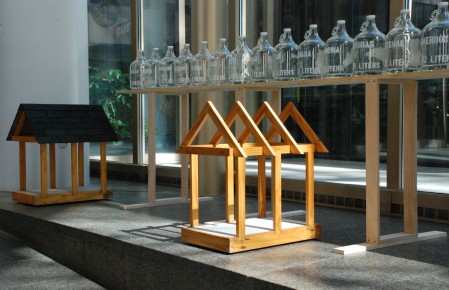Water. Seventy percent of the Earth’s surface is covered with it. But in spite of the 326 million cubic miles of water on Earth, many people do not have access to fresh, clean water.
The basic water requirement (BWR) describes the amount of water a person needs per day for domestic purposes: water for drinking, human hygiene, sanitation services and food preparation. The minimum recommended BWR per person is 50 liters—or a little more than 13 gallons. Unfortunately 20 percent of the world’s population only has around 5 liters—or a little more than 1 gallon—each day. More than 1 billion people do not have access to clean drinking water.
 In response to this global crisis, community artist and APSU professor of art, Gregg Schlanger, has contributed an installation for the Green Light exhibit, now on display at the Bank of America Plaza in Charlotte, N.C.
In response to this global crisis, community artist and APSU professor of art, Gregg Schlanger, has contributed an installation for the Green Light exhibit, now on display at the Bank of America Plaza in Charlotte, N.C.
All works in the Green Light exhibit focus on environmental issues. The bank is sponsoring the show in acknowledgement of its efforts to maintain a more environmentally friendly business and in commemoration of receiving Energy Star Rating of 91. The work is accessible by the public through November 2009.
Schlanger has shown work both nationally and internationally. Exhibits include a community public art commission for Memphis, Tenn., a community project at Providence, R.I., and exhibits in Berlin, Erfurt, Potsdam and Jena, Germany. Schlanger has also displayed work in Illinois, Iowa, Nevada, California, North Carolina, Arkansas, Idaho and Virginia.
He has received many awards including Sponsorship by the New York Foundation for the Arts, Israel-Tennessee Visual Artist Exchange Project Fellowship, USIA Arts America Grant and New Forms Regional Initiative Grant from the National Endowment for the Arts.
Schlanger works primarily in installations and community public art. He is interested in exploring the potential of creating a better “sense of place,” which he hopes will lead others to a deeper respect for the places and the environment. Schlanger believes this can happen through community involvement and the educational nature inherent to many aspects of his work.
Schlanger’s installation is a continuation of a work he created in Potsdam, Germany. There are 48 one-gallon glass bottles on displayed on a wooden table. Each bottle represents a different country and indicates the amount of water used per person per day in each country. The installation also contains a simple three-dimensional line drawing of a house, which is used to represent the domestic use of water around the world.
The installation is for sale for $20,000. If the work is sold, $14,000 of the selling price will be sent to PlayPumps International. This money will provide an entire pumping system that will bring clean drinking water to 2,500 people for 10 years. PlayPumps International has supplied drinking water to more than 10 million people in many countries in Africa.
“It is my intention to bring awareness about this global (water) crisis through this piece,” says Schlanger. “As a global community, we should guarantee that every person has access and the right to at least 50 liters of clean water every day.”
The country with the poorest access to water is Somalia with less than 1 liter per person per day. Ethiopia, Chad, Sierra Leone and Haiti are all countries where people have less than 15 liters water per day to use for their basic needs. In contrast, Iceland leads the European countries with the average person using 507 liters per day. The U.S., New Zealand and Canada are among countries with the highest water usages. Each person in the U.S. uses an average of 598 liters of water per day.
Water is one of the key ingredients for life to exist. The lack of proper drinking water is blamed for the deaths of 5,000 children every day. In certain parts of Africa, women will spend hours each day hunting for water. Meanwhile, modernized nations waste water by the hundreds of gallons.
For more information about the global water crisis, the work of Schlanger or to find out what you can do to help, contact Schlanger, (931) 221-7789. For more information about PlayPumps International, visit http://www.playpumps.org.
Some Facts about Water:
- Toilets in Toronto, Canada, are flushed more than 20 times per person, per day.
- Less than 1 percent of the world’s fresh water (or about 0.007 percent of all water on Earth) is readily accessible for direct human uses.
- \A small drip from a faucet can waste as much as 75 liters of water a day.
- The total amount of water on our planet has remained the same for 2 billion years.
- The average amount of fresh water used globally is 69 percent for agricultural, 23 percent for industry and 8 percent for domestic purposes.
- It takes 185 liters of water to produce a glass of milk.
- The cost of providing safe drinking water and proper sanitation to everyone in the world by 2025 will be U.S. $180 billion per year.
- More than 5,000 children die each day due to unclean water and poor sanitation.
- In parts of Africa, women and girls spend as much as three hours a day gathering water.
- In the year 2000, 89 billion liters of water were bottled and traded globally.
- Kuwait has no lakes or rivers, so it depends on desalination for all of its water.
- Californians have roughly 560,000 swimming pools.
- It takes 150,000 liters of water to make an automobile.
Photography Credits: All photographs were taken by Greg Schlanger, professor of art at Austin Peay State University.




